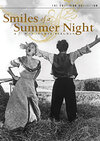Ingmar Bergman (1918–2007)
Author of The Magic Lantern: An Autobiography
About the Author
Series
Works by Ingmar Bergman
Four Screen Plays of Ingmar Bergman: Smiles of a Summer Night - The Seventh Seal - Wild Strawberries - The Magician (1949) 269 copies
Four Stories by Ingmar Bergman: The Touch, Cries and Whispers, The Hour of the Wolf, The Passion of Anna (1976) 34 copies
Torment [1944 film] — Screenwriter — 26 copies
Secrets of Women [1952 film] 12 copies
Thirst [1949 film] — Director — 11 copies
Criterion 101 — Director — 9 copies
Crisis [1946 film] 9 copies
From the Life of the Marionettes [1980 film] — Director — 8 copies
The Rite [1969 TV movie] — Director/Screenwriter — 8 copies
Four Masterworks (Smiles of a Summer Night / The Seventh Seal / Wild Strawberries / The Virgin Spring) (2007) — Director — 8 copies
Dreams [1955 film] 7 copies
All These Women [1964 film] — Director — 6 copies
The Touch [1971 film] — Director — 6 copies
Prison [1949 film] 5 copies
Pittura su legno: una morality play 4 copies
Persona [screenplay] 4 copies
Bergman's 20th century: a tribute to Swedish film, from Victor Sjöström to Lukas Moodysson (2000) 3 copies
The Serpent's Egg | The Hour of the Wolf | The Passion of Anna | The Touch | Cries and Whispers (1980) 3 copies
The Magic Lantern, Part 1 3 copies
Winter Light | Through a Glass Darkly | The Silence | The Rite | Cries and Whispers | Persona 3 copies
A Ship Bound for India [1947 film] — Director — 3 copies
Fanny och Alexander 3 copies
Fanny & Alexander, Part 2/4 2 copies
The Seventh Seal | Wild Strawberries | The Silence — Director — 2 copies
Il vangelo secondo Bergman. Storia di un capolavoro mancato. Testo svedese a fronte. Ediz. bilingue (2018) 2 copies
Fanny & Alexander, Part 3/4 2 copies
Fanny & Alexander, Part 4/4 2 copies
Schwarzer Zucker. Roman. 2 copies
Stimulantia [1967 film] 2 copies
It Rains on Our Love [1946 film] 2 copies
Moraliteter : tre pjäser 2 copies
Stilheden 1 copy
Les Fraises sauvages (1952) 1 copy
Le Septième Sceau (1957) 1 copy
Cris et chuchotements (1972) 1 copy
Sonata do Outono 1 copy
The Rite 1 copy
Fårö Document 1 copy
Fårö Document 1979 1 copy
Quattro film Sorrisi di una notte d'estate Il settimo sigillo Il posto delle fragole Il volto 1 copy
Obrazy 1 copy
Tras el ensayo 1 copy
Cena de Um casamento 1 copy
YABAN ÇİÇEKLERİ 1 copy
YEDİNCİ MÜHÜR 1 copy
AYNADAKİ GİBİ SESSİZLİK 1 copy
Sonate d'automne 1 copy
Título Teste 1 copy
Woman Without a Face [1947 film] — Author — 1 copy
Artiklar, essäer, föredrag 1 copy
A Film Trilogy by Ingmar Bergman (Through a Glass Darkly / Winter Light / The Silence) — Director — 1 copy
Winter Light [screenplay] 1 copy
Fanny & Alexander, Part 1/4 1 copy
Seventh Seal [Blu-ray] 1 copy
Sepoty a vykriky 1 copy
İmgeler 1 copy
Ich schreibe Filme: Arbeitstagebücher 1955–2001: Arbeitstagebücher 1955-2001. Ingmar Bergmann (2021) 1 copy
Piąty akt 1 copy
Cuatro obras 1 copy
VIDA DE MARIONETES 1 copy
Skepp till Indialand [1947 film] — Director — 1 copy
Pildid : [mälestusteraamat] 1 copy
Faithless [short story] 1 copy
Associated Works
Stephen Sondheim: A little night music [theatre programme] — Contributor — 1 copy
Tagged
Common Knowledge
- Legal name
- Bergman, Ernst Ingmar
- Birthdate
- 1918-07-14
- Date of death
- 2007-07-30
- Burial location
- Fårö Cemetery, Gotland, Sweden
- Gender
- male
- Nationality
- Sweden (birth)
- Birthplace
- Uppsala, Sweden
- Place of death
- Fårö, Sweden
- Cause of death
- natural causes
- Places of residence
- Uppsala, Sweden
Stockholm, Sweden
Fårö, Sweden
Munich, Bavaria, Germany - Education
- Stockholm University
- Occupations
- film director
screenwriter
autobiographer - Relationships
- Ullmann, Linn (daughter)
Ullmann, Liv (lover)
Fisher, Else (wife)
Lundström, Ellen (wife)
Grut, Gun (wife)
Laretei, Käbi (wife) (show all 9)
von Rosen, Ingrid (wife)
Andersson, Harriet (lover)
Andersson, Bibi (lover) - Awards and honors
- Goethepreis der Stadt Frankfurt (1976)
Erasmusprijs (1965)
Members
Discussions
Recent viewings in Experimental Film and Video (April 2013)
Reviews
Lists
Awards
You May Also Like
Associated Authors
Statistics
- Works
- 203
- Also by
- 4
- Members
- 4,425
- Popularity
- #5,662
- Rating
- 4.0
- Reviews
- 66
- ISBNs
- 519
- Languages
- 25
- Favorited
- 9






















